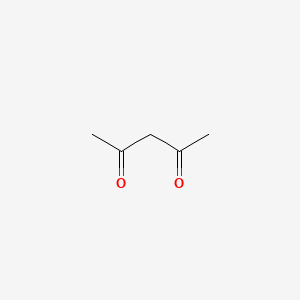| MeSH term | MeSH ID | Detail |
|---|---|---|
| Adenocarcinoma | D000230 | 166 associated lipids |
| Dermatitis, Contact | D003877 | 59 associated lipids |
| Body Weight | D001835 | 333 associated lipids |
| Edema | D004487 | 152 associated lipids |
| Purpura, Thrombocytopenic | D011696 | 2 associated lipids |
| Glioma | D005910 | 112 associated lipids |
| Nervous System Diseases | D009422 | 37 associated lipids |
| Seizures | D012640 | 87 associated lipids |
| Fetal Resorption | D005327 | 15 associated lipids |
| Carcinoma, Lewis Lung | D018827 | 22 associated lipids |
2,4-pentanedione
2,4-pentanedione is a lipid of Fatty Acyls (FA) class. The related lipids are Butyrates.
Cross Reference
Introduction
To understand associated biological information of 2,4-pentanedione, we collected biological information of abnormalities, associated pathways, cellular/molecular locations, biological functions, related genes/proteins, lipids and common seen animal/experimental models with organized paragraphs from literatures.
What diseases are associated with 2,4-pentanedione?
There are no associated biomedical information in the current reference collection.
Possible diseases from mapped MeSH terms on references
We collected disease MeSH terms mapped to the references associated with 2,4-pentanedione
PubChem Associated disorders and diseases
What pathways are associated with 2,4-pentanedione
There are no associated biomedical information in the current reference collection.
PubChem Biomolecular Interactions and Pathways
Link to PubChem Biomolecular Interactions and PathwaysWhat cellular locations are associated with 2,4-pentanedione?
There are no associated biomedical information in the current reference collection.
What functions are associated with 2,4-pentanedione?
There are no associated biomedical information in the current reference collection.
What lipids are associated with 2,4-pentanedione?
Related references are published most in these journals:
| Lipid concept | Cross reference | Weighted score | Related literatures |
|---|
What genes are associated with 2,4-pentanedione?
There are no associated biomedical information in the current reference collection.
What common seen animal models are associated with 2,4-pentanedione?
There are no associated biomedical information in the current reference collection.
NCBI Entrez Crosslinks
All references with 2,4-pentanedione
Download all related citations| Authors | Title | Published | Journal | PubMed Link |
|---|---|---|---|---|
| Lien LF and Beattie DS | Comparisons and modifications of the colorimetric assay for delta-aminolevulinic acid synthase. | 1982 | Enzyme | pmid:7140715 |
| Beaumier PL and Hwang KJ | An efficient method for loading indium-111 into liposomes using acetylacetone. | 1982 | J. Nucl. Med. | pmid:7108630 |
| Pant J et al. | Synthesis and pharmacological studies of 2'-sulphonyl[3-(3H-2,4-disubstituted-1,5-benzodiazepino)]-2,5-dimethyl-6,7-benzomorphans. | 1982 | Pharmazie | pmid:7100235 |
| Shukla AK and Schauer R | Fluorimetric determination of unsubstituted and 9(8)-O-acetylated sialic acids in erythrocyte membranes. | 1982 | Hoppe-Seyler's Z. Physiol. Chem. | pmid:7076126 |
| Gorshkova II et al. | [Role of arginine residues in phenylalanyl-tRNA synthetase interaction with substrates]. | 1980 | Mol. Biol. (Mosk.) | pmid:7015113 |
| Gemant A | Inhibition of oxidation by peroxidase of human serum proteins. | 1977 | Mol. Biol. Rep. | pmid:69989 |
| Jensen NP et al. | Use of acetylacetone to prepare a prodrug of cycloserine. | 1980 | J. Med. Chem. | pmid:6987402 |
| Datta S et al. | Antimicrobial, insect sterilizing and ovicidal activity of some oxo-vanadium(IV) and oxo-vanadium(V) complexes. | 1982 | Agents Actions | pmid:6983826 |
| Mastropaolo D et al. | Hydrogen bonding interaction of diphenylhydantoin and 9-ethyladenine. | 1983 | Mol. Pharmacol. | pmid:6835197 |
| Peters AM et al. | A comparison of indium-111-oxine and indium-111-acetylacetone labelled leucocytes in the diagnosis of inflammatory disease. | 1982 | Br J Radiol | pmid:6814561 |
| Rao SA and Dewanjee MK | Comparative evaluation of red cell-labeling parameters of three lipid-soluble- 111In-chelates: effect of lipid solubility on membrane incorporation and stability constant on transchelation. | 1982 | Eur J Nucl Med | pmid:6809466 |
| Sinn H | Comparison of [111In]oxine and [111In]Acetylacetone for the labeling of cells: in vivo and in vitro biological testing. | 1982 | Int J Appl Radiat Isot | pmid:6806200 |
| Burke JE et al. | The comparison of 8-hydroxyquinoline, tropolone, and acetylacetone as mediators in the labelling of polymorphonuclear leucocytes with indium-111: a functional study. | 1982 | Eur J Nucl Med | pmid:6806102 |
| Pandian S et al. | Perturbed angular correlation studies of 111In-labelled platelets. | 1982 | Int J Appl Radiat Isot | pmid:6800963 |
| Goedemans WT | Simplified cell labelling with indium-111 acetylacetonate and indium-111 oxinate. | 1981 | Br J Radiol | pmid:6789921 |
| Danpure HJ and Osman S | Cell labelling and cell damage with indium-111 acetylacetone-an alternative to indium 111 oxine. | 1981 | Br J Radiol | pmid:6789920 |
| Tishler PV and Winston SH | Simple screening test for qualitative detection of increased delta-aminolevulinic acid in urine. | 1984 | Clin. Chem. | pmid:6744588 |
| Smith FA et al. | PAC studies of 111In binding to transferrin, tropolone and acetylacetone in aqueous solutions. | 1984 | Int J Appl Radiat Isot | pmid:6735495 |
| Cole SC and Kuwahara SS | Acetylacetone method for glycine improved by use of ammonium citrate buffer. | 1984 | Clin. Chem. | pmid:6733911 |
| Fregert S et al. | A simple method for the detection of formaldehyde. | 1984 | Contact Derm. | pmid:6713848 |
